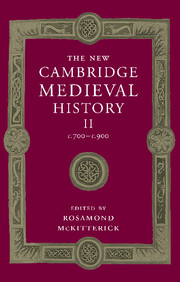Book contents
- Frontmatter
- PART I POLITICAL DEVELOPMENT
- 1 Introduction: sources and interpretation
- 2 The British Isles
- 3 Frankish Gaul to 814
- 4 The Frankish kingdoms, 814–898: the West
- 5 The Frankish Kingdoms, 817–911: the East and Middle Kingdoms
- 6 Fines Imperii: the Marches
- 7 The Vikings in Francia and Anglo-Saxon England to 911
- 8 Scandinavia, c. 700–1066
- 9 Slavs and Bulgars
- 10 The Muslims in Europe
- 11 Spain: the northern kingdoms and the Basques, 711–910
- 12 Lombard and Carolingian Italy
- 13 Byzantine Italy, c. 680–c. 876
- 14 Byzantium and the west, 700–900
- PART II GOVERNMENT AND INSTITUTIONS
- PART III CHURCH AND SOCIETY
- PART IV CULTURE AND INTELLECTUAL DEVELOPMENTS
- Conclusion
- Appendix genealogical tables
- List of primary sources
- Bibliography of secondary works arranged by chapter
- Index of manuscripts
- General index
- Frontispiece">
- Plate section
- Map 4 Charlemagne’s Europe and Byzantium, 814
- Map 19 The ecclesiastical provinces of western Europe 700-900
- Map 20 Carolingian schools, scriptoria and literary centres
- Genealogical table X: Wessex
- References
8 - Scandinavia, c. 700–1066
from PART I - POLITICAL DEVELOPMENT
Published online by Cambridge University Press: 28 March 2008
- Frontmatter
- PART I POLITICAL DEVELOPMENT
- 1 Introduction: sources and interpretation
- 2 The British Isles
- 3 Frankish Gaul to 814
- 4 The Frankish kingdoms, 814–898: the West
- 5 The Frankish Kingdoms, 817–911: the East and Middle Kingdoms
- 6 Fines Imperii: the Marches
- 7 The Vikings in Francia and Anglo-Saxon England to 911
- 8 Scandinavia, c. 700–1066
- 9 Slavs and Bulgars
- 10 The Muslims in Europe
- 11 Spain: the northern kingdoms and the Basques, 711–910
- 12 Lombard and Carolingian Italy
- 13 Byzantine Italy, c. 680–c. 876
- 14 Byzantium and the west, 700–900
- PART II GOVERNMENT AND INSTITUTIONS
- PART III CHURCH AND SOCIETY
- PART IV CULTURE AND INTELLECTUAL DEVELOPMENTS
- Conclusion
- Appendix genealogical tables
- List of primary sources
- Bibliography of secondary works arranged by chapter
- Index of manuscripts
- General index
- Frontispiece">
- Plate section
- Map 4 Charlemagne’s Europe and Byzantium, 814
- Map 19 The ecclesiastical provinces of western Europe 700-900
- Map 20 Carolingian schools, scriptoria and literary centres
- Genealogical table X: Wessex
- References
Summary
at the beginning of the eighth century Scandinavia was politically amorphous. By the end of the three and a half centuries surveyed in this chapter three independent kingdoms and one ‘republic’ had formed in this part of Europe (Map 14).
The political structure of Scandinavia before the eighth century eludes us. The claims made for a dark-age kingdom of the Svear controlling all Sweden and large parts of the Baltic area are no doubt exaggerated. The Götar are not mentioned in ninth-century sources and this has led some scholars to assume that at some point between 500 and 900 they had been absorbed by the Svear. Later evidence, however, shows conclusively that the Götar were recognised as an independent people well into the twelfth century. Foreign observers often give a misleading impression because they were familiar only with the Svear. At the beginning of the eighth century Sweden was divided into several regions effectively separated from each other by natural obstacles, mainly thick and trackless forests (Map 15).
In Norway geographical conditions similarly determined the limits for any concentration of power. Most communication was by sea. Naval forces therefore were prerequisites for anyone aspiring to power over larger tracts of Norway. Distances were vast; the distance between the southern and northern limits of Scandinavia matches that from York to Gibraltar. Southeast Norway therefore came as naturally into the sphere of interest of Danish princes as into that of princes based in western or northern Norway, and there is nothing to suggest that Norway was ever united under one ruler or even regarded as a separate territorial or national entity before the Viking period.
Keywords
- Type
- Chapter
- Information
- The New Cambridge Medieval History , pp. 202 - 227Publisher: Cambridge University PressPrint publication year: 1995
References
- 4
- Cited by

